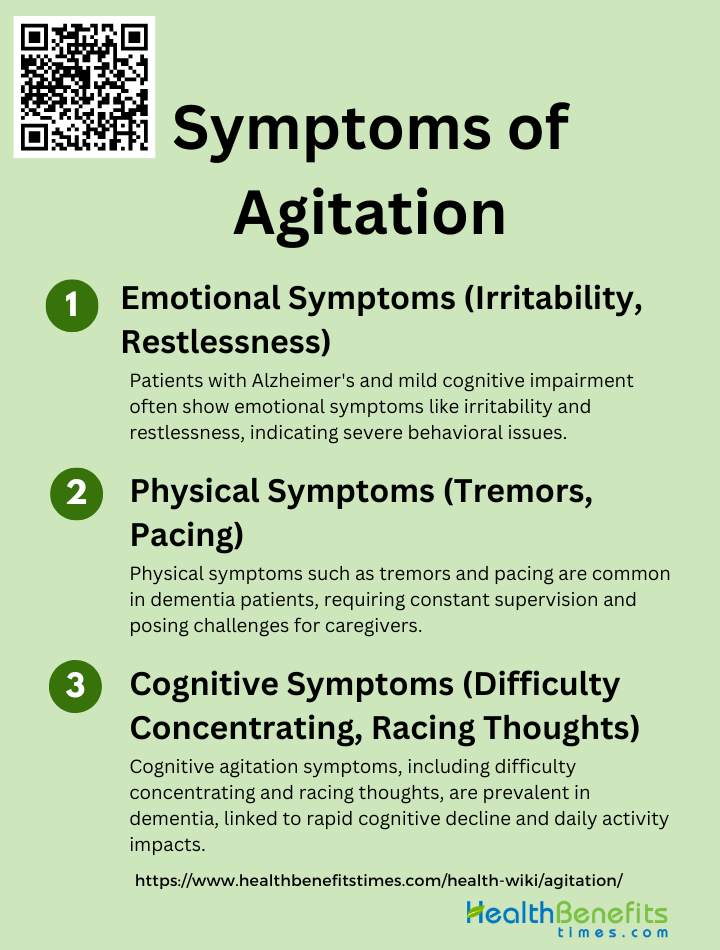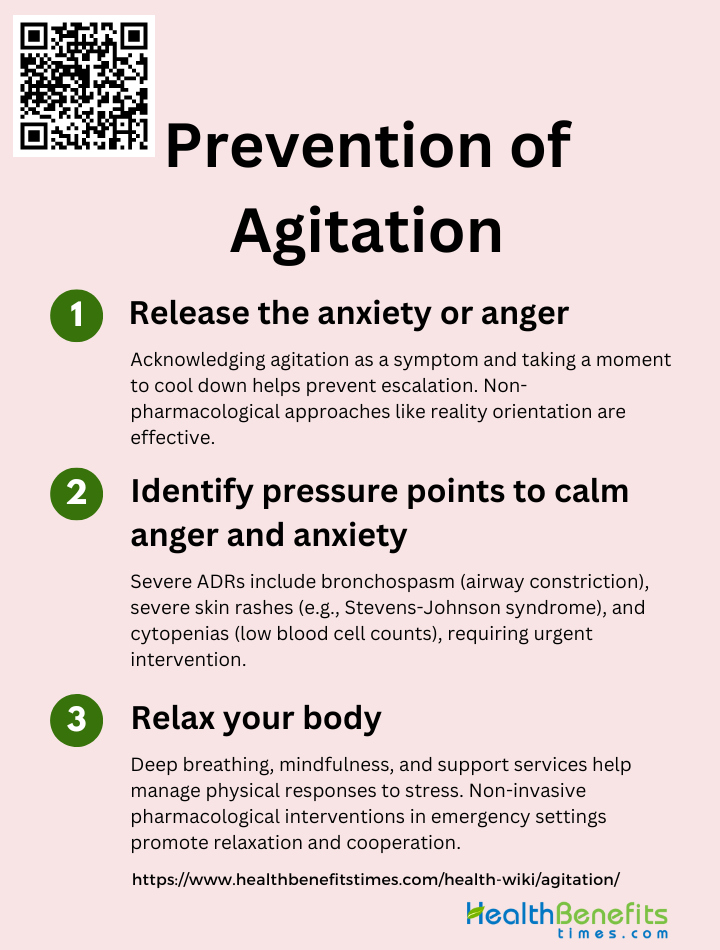 Agitation is a state of extreme emotional disturbance characterized by feelings of restlessness, irritability, and unease. It often manifests through physical symptoms such as pacing, hand-wringing, and fidgeting, as well as verbal outbursts and difficulty sitting still. Agitation can be triggered by various factors, including stress, mental health disorders like schizophrenia, bipolar disorder, and dementia, as well as substance withdrawal and certain medical conditions. While it is a common response to stress, persistent or severe agitation may indicate an underlying health issue that requires medical attention.
Agitation is a state of extreme emotional disturbance characterized by feelings of restlessness, irritability, and unease. It often manifests through physical symptoms such as pacing, hand-wringing, and fidgeting, as well as verbal outbursts and difficulty sitting still. Agitation can be triggered by various factors, including stress, mental health disorders like schizophrenia, bipolar disorder, and dementia, as well as substance withdrawal and certain medical conditions. While it is a common response to stress, persistent or severe agitation may indicate an underlying health issue that requires medical attention.
Causes of Agitation
Whether due to psychological stressors, environmental triggers, or physiological imbalances, understanding these causes is the first step toward managing the symptoms. Below is a list of common factors that may lead to agitation.
1. Psychological factors
Psychological factors play a significant role in the onset of agitation. Agitation can often be a symptom of underlying psychiatric disorders such as anxiety, depression, or schizophrenia. Dysregulations in neurotransmitter systems, including dopaminergic, serotonergic, noradrenergic, and GABAergic pathways, are commonly implicated in these conditions. For instance, individuals with dementia may exhibit agitation due to unmet care needs or biopsychosocial problems, which can be exacerbated by psychological stressors. Addressing these psychological factors through appropriate therapeutic interventions can help mitigate agitation, often irrespective of its etiology.
2. Medical conditions
Medical conditions are another critical cause of agitation, particularly in older adults. Agitation in nursing home residents has been linked to various medical and psychiatric diagnoses, including dementia, cognitive impairments, and physical pain. For example, aggressive behaviors such as hitting or kicking are often associated with dementia and impairments in daily living activities, while non-aggressive behaviors like pacing are correlated with cognitive impairments and fewer medical diagnoses. Understanding the medical underpinnings of agitation can aid in developing targeted treatment plans that address both the physical and mental health needs of the individual.
3. Environmental triggers
Environmental factors can significantly contribute to agitation, especially in vulnerable populations such as those with dementia. Agitation can be triggered by unmet care needs or environmental stressors, including noise, overcrowding, or even the actions of caregivers. Non-pharmacological interventions, such as creating a calm and structured environment, are often the first line of action to manage agitation in these settings. By identifying and modifying environmental triggers, caregivers can help reduce the frequency and severity of agitated behaviors, thereby improving the overall quality of care and life for affected individuals.
Symptoms of Agitation
Agitation can manifest in various ways, often signaling an underlying issue that requires attention. Recognizing the symptoms early is crucial for addressing the root cause and finding an appropriate solution. Below is a list of common signs that someone may be experiencing agitation.
1. Emotional Symptoms (Irritability, Restlessness)
Agitation in patients with cognitive impairments such as mild cognitive impairment (MCI) and Alzheimer’s dementia (AD) often manifests as emotional symptoms like irritability and restlessness. These emotional disturbances are more pronounced in patients with AD compared to those with MCI, with a higher prevalence of agitation observed in AD patients (76%) than in MCI patients (60%). Emotional symptoms such as irritability and restlessness are linked to more severe behavioral and depressive symptoms, as measured by various scales like the Middelheim Frontality Score (MFS) and the Cornell Scale for Depression in Dementia (CSDD). Additionally, these symptoms are often associated with cognitive decline and impaired social functioning, further exacerbating the emotional distress experienced by patients.
2. Physical Symptoms (Tremors, Pacing)
Physical symptoms of agitation, such as tremors and pacing, are commonly observed in patients with dementia and other cognitive impairments. These behaviors are often categorized into aggressive and non-aggressive types. For instance, physically non-aggressive behaviors like pacing are correlated with cognitive impairment and fewer concurrent medical diagnoses. In Alzheimer’s disease, physical agitation is linked to specific neurobiological changes, including reduced glucose metabolism in the right temporal, right frontal, and bilateral cingulate cortex. These physical manifestations of agitation can be particularly challenging for caregivers, as they often require constant supervision and intervention to ensure the safety of the patient. The prevalence of such physical symptoms is notably high in nursing home residents, affecting up to 80% of individuals.
3. Cognitive Symptoms (Difficulty Concentrating, Racing Thoughts)
Cognitive symptoms of agitation, such as difficulty concentrating and racing thoughts, are prevalent in various forms of dementia, including Alzheimer’s disease. These cognitive disturbances are often accompanied by other neuropsychiatric symptoms like disorganized thinking and perceptual disturbances. In patients with Alzheimer’s dementia, cognitive symptoms of agitation are linked to frontal and temporal lobe pathology, which may contribute to the severity of these symptoms. The presence of cognitive agitation is also associated with a more rapid rate of cognitive decline and can significantly impact the patient’s ability to perform daily activities. Understanding the cognitive aspects of agitation is crucial for developing targeted interventions that can help alleviate these distressing symptoms and improve the quality of life for both patients and caregivers.
Managing Agitation
It requires a strategic approach to identify the triggers, understand the underlying causes, and implement effective techniques to alleviate the tension. Below are key steps to consider when managing agitation:
1. Non-pharmacological approaches
Non-pharmacological interventions are increasingly recognized as the first-line approach for managing agitation in various conditions, including dementia and emergency settings. According to NICE guidelines, these interventions should be prioritized due to their lower risk profile compared to pharmacological treatments. Effective non-pharmacological strategies include music therapy, doll therapy, physical activity, and person-centered communication skills, which aim to enhance overall well-being and prevent the occurrence of agitation. In emergency settings, patient-centered approaches that incorporate interpersonal calming skills and environmental modifications are recommended to manage agitation effectively. These methods not only reduce emotional distress but also improve patient cooperation and outcomes.
2. Pharmacological treatments
Pharmacological treatments are often considered when non-pharmacological approaches fail to manage agitation effectively. Atypical antipsychotics, such as risperidone and quetiapine, are commonly prescribed but come with significant safety concerns, including the risk of stroke and mortality. Newer pharmacological options, such as inhaled loxapine, dextromethorphan/quinidine, and cannabinoids, show promise but require further research to establish their safety and efficacy. In Alzheimer’s disease, medications like memantine, carbamazepine, and citalopram have shown some preliminary benefits but are not yet recommended for routine clinical practice due to insufficient evidence. Overall, pharmacological interventions should be used judiciously, with careful monitoring and consideration of potential adverse effects.
When to seek professional help for Agitation
Persistent or severe agitation disrupting daily life warrants professional help. It may indicate underlying mental health issues like anxiety or depression. Feeling restless, irritable, or losing control necessitates consulting a mental health professional. They evaluate symptoms; identify causes, and offer therapy or medication. Timely intervention prevents agitation escalation, aiding effective management. Seeking help promptly is vital for mitigating agitation’s impact and restoring well-being.
Prevention and Coping Strategies of Agitation
Developing effective prevention and coping strategies is essential to maintaining emotional balance and well-being. Below is a list of practical approaches to help mitigate and manage agitation when it occurs.
1. Release the anxiety or anger
Releasing anxiety or anger is a crucial step in managing agitation. Family carers of individuals with dementia have found that acknowledging and accepting agitation as a symptom of the condition helps in managing their emotional responses. They often ensure the safety of their relative first and then take a moment to walk away, allowing themselves time to cool down and release their own anxiety or anger. This approach helps in preventing the escalation of agitation and maintaining a calm environment. Additionally, nonpharmacological approaches such as reality orientation and validation therapy can be effective in reducing anxiety and anger, thereby preventing agitation.
2. Identify pressure points to calm anger and anxiety
Identifying pressure points to calm anger and anxiety involves understanding the underlying causes of these emotions. Careers have found that maintaining a familiar routine and addressing the root causes of agitation, such as unmet needs or discomfort, can significantly reduce these feelings1. The International Psychogeriatric Association recommends a thorough investigation of the behavior to identify triggers and plan appropriate interventions. This approach, known as the Investigate, Plan, and Act (IPA) method, emphasizes shared decision-making and continuous assessment to ensure the effectiveness of the strategies employed. Environmental modifications and therapeutic activities are also effective in calming anger and anxiety by creating a soothing and supportive atmosphere.
3. Relax your body
Relaxing the body is an essential strategy for coping with agitation. Techniques such as deep breathing, progressive muscle relaxation, and mindfulness can help individuals manage their physical responses to stress and agitation. Careers have reported that taking time for themselves and using support services for emotional and practical help can significantly reduce their stress levels, allowing them to remain calm and composed. In emergency settings, non-invasive pharmacological interventions, such as inhaled medications, can also help in rapidly calming agitated patients without over-sedating them, thereby promoting relaxation and cooperation. These strategies, combined with a patient-centered approach, can effectively manage agitation and improve overall well-being.



